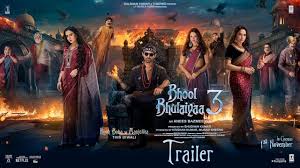Discover how Indian thrillers masterfully exploit human fears to create spine-chilling suspense. Learn the techniques, cultural influences, and psychological tricks that keep audiences on the edge of their seats.
Indian thrillers have mastered the art of suspense by tapping into deep-seated human fears. From psychological trauma to societal anxieties, these films and series use fear as a tool to grip audiences and create unforgettable cinematic experiences. But what makes Indian thrillers so uniquely terrifying? How do they exploit human fear to maximize suspense?
In this article, we explore the various techniques Indian thrillers use to evoke fear, compare them with Hollywood’s approach, and analyze why they continue to captivate audiences worldwide.
The Psychology of Fear in Indian Thrillers
1. The Fear of the Unknown
One of the most powerful elements in Indian thrillers is the fear of the unknown. Films like Kahaani (2012) and Andhadhun (2018) create suspense by withholding key information from both the protagonist and the audience, leading to an intense sense of unpredictability.
2. Supernatural and Mythological Horror
Indian culture is rich with folklore, myths, and spiritual beliefs, making supernatural elements a natural fit for thrillers. Films like Tumbbad (2018) and Stree (2018) use traditional legends to amplify fear, blending the supernatural with real-life anxieties.
3. Social and Political Fears
Unlike Hollywood, which often focuses on individual fears, Indian thrillers frequently tackle societal issues. Movies like Article 15 (2019) highlight systemic oppression and injustice, making the fear deeply relatable to audiences.
Techniques Used to Build Suspense
1. Non-Linear Storytelling
Many Indian thrillers, such as Drishyam (2013), use non-linear narratives to keep audiences guessing. By revealing key information in unexpected ways, filmmakers create an ongoing sense of tension.
2. Cinematic Elements: Lighting, Sound, and Silence
Suspense in Indian thrillers is often heightened through masterful use of cinematography. Dark, shadowy lighting, eerie soundscapes, and strategic silences are common techniques used to make viewers feel unsettled.
3. The Unreliable Narrator
A compelling storytelling method in Indian thrillers is the use of an unreliable narrator. Films like Ratsasan (2018) and Badla (2019) challenge audience perceptions, keeping them second-guessing every plot twist.
Bollywood vs. Hollywood: How Thrillers Borrow and Adapt Stories
1. Psychological vs. Action-Packed Thrillers
Hollywood thrillers often emphasize action and high-stakes chases, while Bollywood focuses on deep psychological manipulation. Films like Ugly (2013) delve into human depravity and desperation rather than relying on sheer action sequences.
2. Cultural Context and Emotional Depth
Indian thrillers integrate cultural elements that make their stories more immersive. Unlike Hollywood’s often straightforward narratives, Indian thrillers tend to be deeply emotional, making the fear more personal and resonant.
3. Adaptation of International Concepts
While many Indian thrillers draw inspiration from global cinema, they are often localized to make the story more relevant. For example, Badla (2019) is an adaptation of the Spanish thriller The Invisible Guest, but with twists that cater to Indian audiences.
Why Indian Thrillers Keep Audiences Hooked
1. Emotional Investment in Characters
Indian films prioritize character depth, making audiences emotionally invested in their fates. This enhances the impact of suspenseful moments, making the tension feel more real.
2. Blending of Genres
Unlike Hollywood, where genres tend to be rigidly defined, Indian thrillers frequently mix elements of horror, drama, and mystery, keeping audiences engaged through varied storytelling techniques.
3. The Element of Surprise
Many Indian thrillers are known for their unexpected twists. Films like Ek Hasina Thi (2004) and Talvar (2015) keep audiences guessing until the very last moment, ensuring maximum engagement.
The Future of Indian Thrillers
As Indian cinema continues to evolve, thrillers are becoming more innovative and globally relevant. With the rise of streaming platforms like Netflix and Amazon Prime, Indian thrillers are reaching a wider audience, pushing filmmakers to experiment with new storytelling methods and higher production values.
Indian thrillers exploit human fear in ways that resonate deeply with audiences. By weaving psychological tension, societal issues, and supernatural elements into their narratives, these films create a unique brand of suspense that sets them apart from Hollywood thrillers. As the genre continues to evolve, Indian thrillers are poised to become even more sophisticated, gripping, and globally influential.
FAQ
1. What makes Indian thrillers different from Hollywood thrillers?
Indian thrillers often focus on psychological depth, societal issues, and emotional storytelling, while Hollywood thrillers tend to emphasize action and fast-paced narratives.
2. What are some must-watch Indian thriller movies?
Some top Indian thrillers include Andhadhun (2018), Drishyam (2013), Kahaani (2012), and Ratsasan (2018).
3. Why do Indian thrillers often include supernatural elements?
India’s rich folklore and cultural beliefs make supernatural elements a natural fit for thriller storytelling, adding layers of fear and suspense.
4. How do Indian thrillers keep audiences engaged?
Through character-driven storytelling, non-linear narratives, and unexpected twists, Indian thrillers create a deep emotional and psychological impact on audiences.
5. What are some upcoming trends in Indian thrillers?
The future of Indian thrillers includes more psychological horror, real-life crime adaptations, and increased experimentation with international storytelling techniques.
